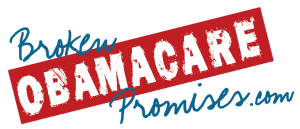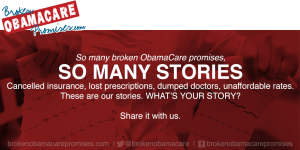By submitting your name, stories, or images (the “Released Subject Matter”) to mycancellation.com, you hereby affirm and agree that you freely, and without restraint, consent to and grant to Independent Women’s Voice, its agents, assigns, licensees and legal representatives (collectively, “IWV”) the irrevocable, unrestricted, royalty-free right to utilize the Released Subject Matter in all forms and media in all manners, including television, radio, internet, social media, photo, film, print, and all other visual, audio, and video representations. By submitting the Released Subject Matter to mycancellation.com, you hereby waive any right to inspect or approve any finished product created by IWV that utilizes the Released Subject Matter.
The Latest News
Poll: Among Those Affected By Obamacare, More Americans Say They've Been Hurt Than Helped
2/29/2016 3:23:00 PM – Leah Barkoukis
A new National Public Radio/Robert Wood Johnson Foundation found that only 15 percent say they’ve personally benefitted, however. While 56 percent of Americans said the law hasn’t directly affected them, among those who have been affected by it, more people said it has done greater harm than good.
Via The Hill:
Twenty-six percent of U.S. adults say they have been personally harmed by the healthcare law since its passage — a fraction that likely reflects those in the poll who said they have noticed rising healthcare costs in the last several years.
And while the majority of adults said they believed their healthcare costs were “reasonable,” many said those costs were becoming less affordable over time. […]
Twenty-six percent of Americans say the cost of healthcare has been a serious strain on their finances in the last two years. About 40 percent of those facing financial struggles because of their medical bills said they have spent all or most of their savings accounts on large bills. About one in five people said they’ve been forced to forgo prescriptions because they can’t afford them.
The national poll included 1,002 responses and has a margin of error of 3.8.
RELEASE: New Website Sheds Light On ObamaCare Troubles - BrokenObamaCarePromises.com

October 26, 2015
Victoria Coley: victoria.coley@iwvoice.org
Celia Meyer: celia.meyer@iwvoice.org
New Website Sheds Light On ObamaCare Troubles
BrokenObamaCarePromises.com
Giving A Voice To Those Harmed By ObamaCare
Higgins: “The millions of Americans and their families who have been adversely affected by the ironically named “Patient Protection & Affordable Care Act” deserve a better healthcare system, and, certainly deserve to have their voices heard.”
WASHINGTON D.C. — Launching today, a new multi-layered online initiative from the Independent Women’s Voice, BrokenObamaCarePromises.com, invites the public to share their stories of real life experiences with the healthcare law, giving a face to the millions harmed by the law’s broken promises.
President Obama promised that if we liked our plan, we could keep it, but millions of Americans then had their health insurance policies cancelled. Individuals and families were assured ObamaCare would be affordable, but too many have suffered staggering insurance cost increases. Then, Americans discovered their doctor networks and prescription coverage were being limited under ObamaCare. Many poor cancer patients have discovered that now that they are “covered”, it is illegal for cancer treatment centers to give them real treatment as charity, but only are served at places that shunt them to hospice to die rather than treating them. After more than five years of health reform, Americans have proof that all of these promises have consistently been broken.
“Time and again, we have learned that ObamaCare won’t actually do what its proponents promised it would. Americans can expect more broken promises to come,” IWV CEO and President Heather R. Higgins said. “ObamaCare provides neither ‘patient protection’ or ‘affordable care.’ A promise of care that no one will fulfill is no promise, and choices that are only lousy options you never wanted isn’t a choice. Americans and their families who have fallen victim to the law deserve a better healthcare system, and in the meantime, certainly deserve to have their voices heard.”
In 2013, IWV launched My Cancellation, which featured submissions from Americans across the country who received letters from their health insurance providers notifying them that their plans – that they liked – would be cancelled due to ObamaCare. Thousands sent IWV their stories, representing the experience of millions nationwide. Unfortunately, since that time, there have been even more broken ObamaCare promises, and the American people are the ones paying the price.
Broken ObamaCare Promises asks anyone who has been impacted by any of ObamaCare’s staggering harms to submit their story to mystory@brokenobamacarepromises.com. Video testimonials are encouraged.
###
Broken ObamaCare Promises is committed to giving a voice to all Americans who have been harmed by ObamaCare. Broken ObamaCare Promises is an initiative of Independent Women’s Voice’s A Bridge to Better Healthcare project. Independent Women’s Voice is a 501(c)(4) nonpartisan, nonprofit organization for mainstream women, men and families. IWV is the sister organization of the Independent Women’s Forum.

The Decline of ObamaCare
Fewer enrollees and rising loss ratios will force a rewrite in 2017.
Photo: Bloomberg News
Updated Oct. 25, 2015 9:52 p.m. ET
ObamaCare’s image of invincibility is increasingly being exposed as a political illusion, at least for those with permission to be honest about the evidence. Witness the heretofore unknown phenomenon of a “free” entitlement that its beneficiaries can’t afford or don’t want.
This month the Health and Human Services Department dramatically discounted its internal estimate of how many people will join the state insurance exchanges in 2016. There are about 9.1 million enrollees today, and the consensus estimate—by the Congressional Budget Office, the Medicare actuary and independent analysts like Rand Corp.—was that participation would surge to some 20 million. But HHS now expects enrollment to grow to between merely 9.4 million and 11.4 million.
Recruitment for 2015 is roughly 70% of the original projection, but ObamaCare will be running at less than half its goal in 2016. HHS believes some 19 million Americans earn too much for Medicaid but qualify for ObamaCare subsidies and haven’t signed up. Some 8.5 million of that 19 million purchase off-exchange private coverage with their own money, while the other 10.5 million are still uninsured. In other words, for every person who’s allowed to join and has, two people haven’t.
Among this population of the uninsured, HHS reports that half are between the ages of 18 and 34 and nearly two-thirds are in excellent or very good health. The exchanges won’t survive actuarially unless they attract this prime demographic: ObamaCare’s individual mandate penalty and social-justice redistribution are supposed to force these low-cost consumers to buy overpriced policies to cross-subsidize everybody else. No wonder HHS Secretary Sylvia Mathews Burwell said meeting even the downgraded target is “probably pretty challenging.”
The HHS survey shows three of four ObamaCare-eligible uninsured people think having coverage is important—but four of five say they couldn’t fit their share of the premiums into their budgets even after the subsidies. They’re not poor; they tend to have jobs in industries like construction, retail and hospitality but feel insecure financially; and they prioritize items like paying down debt, car repairs or saving to buy a home over insurance.
The law’s failure to appeal to the young and rising middle class is already cascading through the insurance markets. Researchers at the Robert Wood Johnson Foundation and Urban Institute recently published a remarkable study of the industry barometer called medical loss ratios, or MLRs, and the pressure is building fast.
MLRs measure the share of premium revenue that flows to reimbursing medical claims. ObamaCare sets an MLR floor of 80% for patient care, with one-fifth left over for overhead like administration and profits, and the pre-ObamaCare 2010-13 historical trend for the individual market ranged from 79% to 86%.
The researchers found that in 2014—the first full year of claims experience in ObamaCare—average MLRs across all health plans sold on 16 state exchanges roamed from 90% to 99%. Average MLRs in 11 states climbed to 100% or more, reaching as high as 121% in Massachusetts. A business can’t stay solvent for long spending $1.21 for every $1 that comes in.
The 2014 MLRs are used to set rates for 2016 premiums, which are still under regulatory review. But the researchers estimate that to rebound to an MLR of 85%, premiums in the 11 money-losing states need to rise by 10% to 36% in the best estimate and 23% to 52% in the worst scenario. The familiar danger is that as rates rise, more people drop out, and thus rates must rise still higher, as the states that attempted ObamaCare-like regulatory schemes in the 1980s and 1990s discovered.
ObamaCare liberals pose as what-works-and-what-doesn’t technocrats. So perhaps they’d care to explain what it says about their creation that so many rational adults are willing to pay a fine of $695 or 2.5% of their earnings, whichever is higher, for the privilege of not buying an ObamaCare-compliant health plan.
***
ObamaCare will almost inevitably be reopened in 2017, whoever wins the election. The good news is the emerging consensus among Republican candidates about a credible, pragmatic and optimistic alternative. Jeb Bush was the latest to release a plan two weeks ago—and this is a debate that has always deserved to be litigated at the presidential level to create a mandate for reform.
The basic approach is to deregulate insurance and medical practice while replacing ObamaCare’s complex subsidy schedule with a refundable tax credit for individuals who lack job-based coverage. Unchained from benefit and redistribution mandates, insurance products and prices would come to reflect what consumers want. The credit would be sufficient to buy at least coverage for catastrophic expenses if people get sick, and the trade-offs of such skinnier plans might look better to voters priced out of ObamaCare.
GOP reformers also recognize that the Cadillac tax on high-cost employer-sponsored health plans is a heat shield that might let them solve some of the problems of the pre-2010 health finance status quo. Substituting a cap on the tax-code subsidy that helps drive medical inflation is more politically plausible with the Cadillac tax in place than without.
Mr. Bush was shrewd to frame his proposal with the vocabulary of innovation and aspiration. ObamaCare is built on a 20th-century chassis that is ever less relevant to modern medicine and consumer finance. If the law continues to underperform, voters may be open to a new model that puts their choices and needs ahead of the political class’s.

